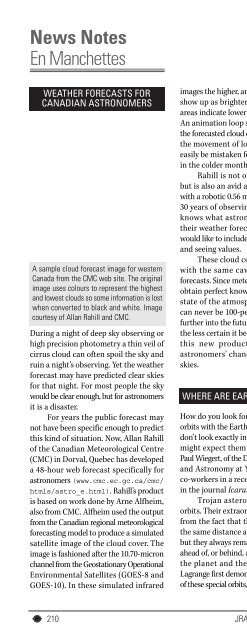I N S I D E T H I S I S S U E
insidethisissue - The Royal Astronomical Society of Canada
insidethisissue - The Royal Astronomical Society of Canada
- No tags were found...
You also want an ePaper? Increase the reach of your titles
YUMPU automatically turns print PDFs into web optimized ePapers that Google loves.
Until January 2000 the Image Reduction and Analysis Facility (IRAF) was used by SSRAL to performthe necessary astrometry to determine the coordinates of the centre of the image and the satellitestreak end-points. The accuracy of the determined coordinates was within 2 arcseconds.The tumble periods range from as low as3.5 seconds (for Molniya 3-39) to over 2minutes (for Molniya 1-75).When analyzing an image, the SSRALtook a specific approach. First, the imagewas examined to make sure there was asatellite streak to analyze. If the imagecontained a satellite streak, the imagewas then loaded into the software packageImage Reduction and Analysis Facility(IRAF). IRAF determined the coordinatesof each end-point of the streak (calledastrometry). Any object that was not asatellite (such as a faint galaxy, asteroid,nebula, etc.) had astrometry performedon it as well. The Right Ascension andDeclination coordinates of the centre ofthe image were also determined in orderto construct an index of images taken ofthe sky. This index contains the coordinatesof the center of the image, the year, month,date and time of the exposure, and thename of the satellite(s) within the image.The image itself is stored in the SSRALimage archive. This process generally took3 minutes per image if only a satellitestreak was being analyzed. The maximumtime was about 10 minutes per image.The data extracted from the images wereused to update the orbital elements ofthe satellite. Molniya satellites were trackedregularly throughout 1998. At the beginningof 1999, the SSRAL began to upgrade itsfacility with remote control and automationin mind.The present:Canadian AutomatedSmall Telescope forOrbital Research(CASTOR)Before January 1999, the SSRAL had askeleton satellite tracking facility in thesense that it had the means to tracksatellites, but it did so impracticably.Steps were taken to upgrade the existingsystem during 1999. These steps includedacquiring a more sensitive CCD camera,a larger aperture telescope, andastronomical software that allowedtelescope automation.SSRAL obtained new astronomicalsoftware called TheSky, manufactured bySoftware Bisque. This software provideda virtual display of the objects in the skyover RMC, including Molniya satellites.It could also be used to control the Meade10-inch telescope. Instead of typing theequatorial coordinates of the object youwanted the telescope to slew to, all thatwas needed was a point and click ontothe object and then another click ontothe “slew” command.The trick was getting the softwareto communicate with the telescopecontroller. After one week’s worth of work,I finally succeeded. An image of a satellitecould be taken every two to three minutes,instead of every three to five minutes,which was previously required. The bulkof the time was the download time of theST-6 CCD camera (1.5 minutes).SSRAL received a new Celestron 14-inch Schmidt-Cassegrain optical tubeassembly in December 1998 and theApogee model AP-7 CCD camera in May1999. The new CCD camera could be usedright away since it could be attached tothe Meade 10-inch telescope withoutdifficulty. The new CCD camera had manyadvantages over the older ST-6. Oneadvantage was that the Apogee CCD chipwas larger (512 by 512 pixels). Anotheradvantage was that the Apogee AP-7camera had a maximum of 85% quantumefficiency over the wavelength regionfrom 600 nm to 800 nm. A final advantagewas that the download time was just 10seconds which was 1 ⁄9 the download timeThe Celestron 14-inch Schmidt-Cassegrainreflecting telescope and the Software BisqueParamount GT-1100 robotic mount are thoroughlytested in the SSRAL lab before being sent tothe new observatory dome for preliminarynight viewing trials. The Apogee AP-7 CCDcamera is shown at the prime focus of thetelescope.216JRASC December / décembre 2000
















